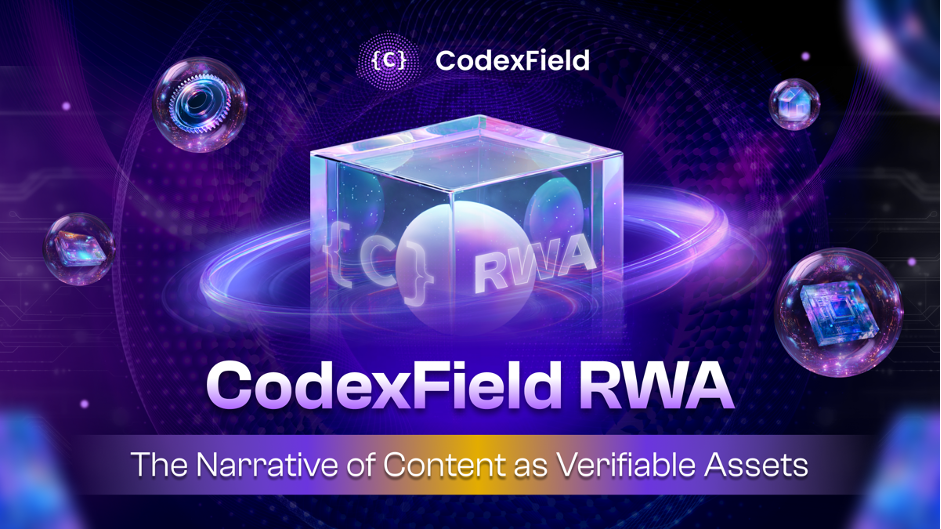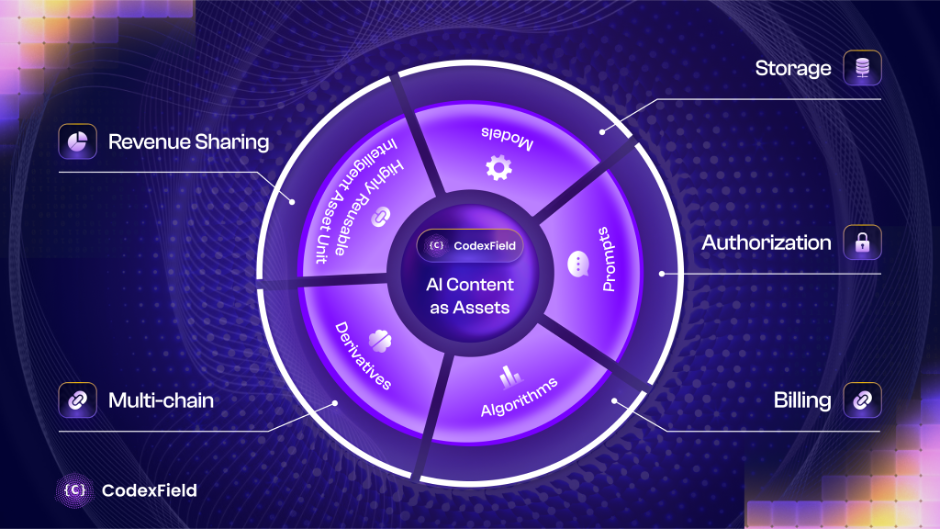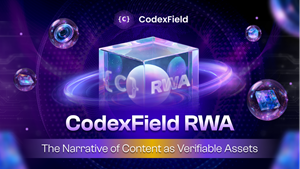CodexField Officially Announces Its Token Framework: Powering the Next Phase of Content and Model Financialization

SINGAPORE, Oct. 14, 2025 (GLOBE NEWSWIRE) -- CodexField officially unveiled its comprehensive token framework, marking a major step in the evolution from the creator economy to full-scale model financialization. The newly announced structure defines how the $CODEX token underpins a Web3-native assetization protocol designed for content creators and AI developers. By enabling content, models, prompts, and algorithms to become confirmable, measurable, and rewardable assets on-chain, CodexField is building a sustainable economic infrastructure where creative and computational outputs can circulate, be priced, and generate profit shares transparently across the network.
In this phase of exponential growth in artificial intelligence and content production, creation and models have long transcended the category of mere works, becoming a new generation of digital production factors. In fact, with the explosive growth of global information, the Web2 world still lacks pathways for the confirmation, measurement, and monetization of these content elements at the value level. Creative acts often fail to form sustainable economic loops. The emergence of CodexField aims precisely to solve this dilemma.
CodexField itself is a Web3-native assetization protocol for content creators and AI developers. Its core goal is to endow structured content such as code, models, prompts, corpora, and graphics/text with the asset attributes of being "confirmable, measurable, and rewardable." By introducing on-chain rights confirmation, programmable authorization, and verifiable settlement mechanisms, CodexField transforms content from data objects into financializable objects, enabling creative activities to circulate, be priced, and generate profit shares across the network as assets.

In terms of system architecture, CodexField supports content assets in value capture and liquidity. It handles the registration of content assets, revenue tracking, and profit-sharing settlement, and uses smart contracts to achieve automated clearing in multi-party collaborations. The platform is also compatible with multiple chains and storage networks, including BNB Chain, Ethereum, Solana, and Greenfield, to ensure that content assets maintain consistent rights confirmation and verifiable settlement in a cross-chain environment.
Currently, CodexField has initially built three key ecosystem components:
- Gitd Toolchain: Allows developers to complete content on-chain registration, authorization definition, and revenue linking within their familiar Git workflow.
- CodexField Marketplace: Serves as the listing and circulation portal for content and models, supporting creators in directly defining commercial licenses and subscription methods.
- Model Fabric Module: Unifies the management of AI model registration, training, inference, and profit-sharing processes, realizing the assetization of model productive capacity.
These components collectively form the protocol foundation of CodexField, enabling the logic of "content as asset" to be implemented in a real system. It is both a developer tool and an institutional infrastructure, undertaking the complete technical path from rights confirmation to revenue.
Within such a system centered on "content as asset," the $CODEX token becomes the key engine driving the economic cycle. It serves as both the medium of exchange, the unit of incentive, and the settlement vehicle for the system, providing the underlying momentum for the sustainable growth of the entire content economy.
The Economic Ecosystem Centered on the $CODEX Token
The $CODEX token is the economic core driving this system. It is both the settlement medium of the system and the value anchor for governance and incentives, forming a stable value cycle between content rights confirmation, model invocation, and revenue distribution.
Within the CodexField system, the functions of the $CODEX token are clearly divided into three tiers: Settlement & Measurement, Governance & Staking, and Incentives & Bandwidth.
First, $CODEX is the default payment and settlement unit of the system.
All content invocations, model training, subscriptions, or re-authorization behaviors within the CodexField system are priced and settled in $CODEX. When a user invokes content or a model, the system automatically generates a usage receipt based on consumption, and payment clearing is conducted in $CODEX. This mechanism allows the value of content and computing power to be measured in real-time, and gives economic activities an auditable and traceable foundation.
Second, $CODEX also undertakes governance and staking functions.
Token holders can stake their tokens into the governance pool to participate in parameter setting for revenue routing and protocol governance decisions. Staking not only reflects the participant's equity status within the ecosystem but also influences profit-sharing weights and system incentive priorities.
Simultaneously, $CODEX itself also fulfills incentive and bandwidth functions.
Developers or platform operators can obtain higher invocation priority, computing power bandwidth quotas, and increased revenue weights by staking $CODEX. For high-frequency users, this mechanism provides both resource guarantees and an incentive design for long-term participation.
Therefore, the functional structure of the $CODEX token runs through the three dimensions of "production, use, and governance." It is both the fuel for the content economy and the equity credential for ecosystem participants.
Self-Sustaining Value Cycle
CodexField's revenue model is built around the principle of "invocation triggers billing, usage triggers profit-sharing." Every content invocation or model training session in the system generates a verifiable economic event and triggers the settlement and burning of $CODEX.
The protocol allocates this portion of revenue proportionally across multiple paths:
- Creators and content providers receive the primary revenue.
- Execution nodes and verification nodes receive service rewards.
- The governance pool receives funds for maintenance and development.
This design creates a positive feedback loop of "multi-role participation" on the distribution end for $CODEX, where ecosystem growth and token demand rise simultaneously.
Meanwhile, the system introduces a long-term deflationary model. As invocation volume increases, a portion of the $CODEX payments are automatically burned upon settlement, thereby reducing the circulating supply in the market. Since the scale of burning is linked to usage volume, ecosystem expansion itself becomes an internal mechanism driving token scarcity. This "usage-driven deflation" structure strongly binds the long-term value of $CODEX to the protocol's actual usage, avoiding the "artificially inflated demand" problem common in early-stage projects.
Pricing Power in the Content Economy
From a market perspective, $CODEX is not merely a settlement token; it represents the pricing power for content and computing power within the CodexField ecosystem. Its price is directly related to the volume of ecosystem activity: when on-chain content volume, model invocation volume, and profit-sharing scale increase, settlement demand rises, while the number of $CODEX circulating in the market correspondingly decreases, forming a positive feedback loop on the supply-demand level.
This structure means that the market value of $CODEX will rely more on the protocol's actual usage and content reuse scale, rather than just speculative trading. As the number of content assets grows, authorization relationships become more complex, and model reuse rates increase, the demand for $CODEX will exhibit a structural growth trend.
From an economic perspective, this native protocol demand is more sustainable than traditional incentive-based inflation mechanisms. It does not rely on short-term mining or subsidies but is driven more by the system's inherent usage logic. Therefore, the more active the CodexField ecosystem, the more robust the economic model of $CODEX becomes, and its token value can better reflect the true level of network usage.
The Golden Cycle of Content Financialization
In fact, globally, the economization process of digital content and AI models is accelerating rapidly. According to Statista data, the global digital content market is expected to exceed $1.2 trillion by 2030; while PwC's "Global AI Outlook" report indicates that the total market for AI models and related applications will reach $2.8 trillion during the same period. Against this backdrop of continuous expansion, even if only 1% of creation, models, and authorization transactions complete rights confirmation and settlement on-chain, the potential circulation scale for CodexField will exceed tens of billions of dollars. This signifies that content assetization is a substantive capitalization track.
From Data Economy to Content Finance
In the last cycle, the core narrative of the Web3 ecosystem was "data rights confirmation." Protocols like Arweave, Ocean Protocol, and Filecoin established the underlying standards for "storage, access, verification." However, with the rapid growth of AI models and content generation, the industry's focus is shifting from "whether data can be preserved" to "how value is settled."
CodexField stands at a new turning point, delving deeper into the value settlement layer, enabling every content use, model invocation, and even secondary derivative behavior to generate a verifiable economic event. This means that CodexField carries the entire "accounting system of the content economy." Consequently, the $CODEX token inherently possesses the triple functions of pricing, settlement, and governance, with its value anchored to the settlement volume of real business.
If we estimate based on the financialization path, the potential space of this market is extremely considerable:
- Assuming that only 1% of the global $4 trillion digital content and AI model market undergoes on-chain rights confirmation and settles using the $CODEX system, the corresponding annualized transaction and settlement volume would reach $40 billion.
- Calculated based on the average 10-20x P/F (Market Cap / Protocol Annual Revenue) valuation multiples of current Web3 infrastructure protocols, the corresponding reasonable valuation range would be approximately $4-8 billion.
- Even under conservative assumptions (capturing only 0.25% of market flow), CodexField's potential valuation could still exceed $1 billion, already entering unicorn territory.
In the short term, CodexField's growth depends primarily on the speed of ecosystem adoption, including the scaled usage of the Gitd toolchain and the Marketplace. In the medium term, with the maturation of Model Fabric and multi-chain deployment, the protocol layer will usher in an explosive period for content rights confirmation and model settlement. In the long run, CodexField may evolve into a bridge between AI and Web3, endowing content assets with measurement and circulation capabilities equivalent to those of financial assets.
In a world where both content and models can be quantified, rights-confirmed, and profit-shared, the long-term value logic of $CODEX will detach from narratives and bind itself to economic activity. What it represents is the underlying settlement currency for the future of content financialization.
For more information, visit the official website, Telegram, X, and YouTube.
Website: codexfield.com
Twitter/X: x.com/CodexField
Telegram: t.me/Codexfield_Official
Telegram Ann: t.me/codexfieldannounce
Youtube: youtube.com/@CodexFieldOfficial
Media Inquiries
Codex team,
business@codexfield.com
Disclaimer: This content is provided by sponsor. The statements, views, and opinions expressed in this content are solely those of the content provider and do not necessarily reflect the views of this media platform or its publisher. We do not endorse, verify, or guarantee the accuracy, completeness, or reliability of any information presented. We do not guarantee any claims, statements, or promises made in this article. This content is for informational purposes only and should not be considered financial, investment, or trading advice.Investing in crypto and mining-related opportunities involves significant risks, including the potential loss of capital. It is possible to lose all your capital. These products may not be suitable for everyone, and you should ensure that you understand the risks involved. Seek independent advice if necessary. Speculate only with funds that you can afford to lose. Readers are strongly encouraged to conduct their own research and consult with a qualified financial advisor before making any investment decisions.Neither the media platform nor the publisher shall be held responsible for any fraudulent activities, misrepresentations, or financial losses arising from the content of this press release. In the event of any legal claims or charges against this article, we accept no liability or responsibility. Globenewswire does not endorse any content on this page.
Legal Disclaimer: This media platform provides the content of this article on an "as-is" basis, without any warranties or representations of any kind, express or implied. We assume no responsibility for any inaccuracies, errors, or omissions. We do not assume any responsibility or liability for the accuracy, content, images, videos, licenses, completeness, legality, or reliability of the information presented herein. Any concerns, complaints, or copyright issues related to this article should be directed to the content provider mentioned above.
Photos accompanying this announcement are available at
https://www.globenewswire.com/NewsRoom/AttachmentNg/7b664693-f8f3-450d-acb4-9879cb1ae72e
https://www.globenewswire.com/NewsRoom/AttachmentNg/81f0fa27-206d-4138-bccd-4b9bd1b57543

Legal Disclaimer:
EIN Presswire provides this news content "as is" without warranty of any kind. We do not accept any responsibility or liability for the accuracy, content, images, videos, licenses, completeness, legality, or reliability of the information contained in this article. If you have any complaints or copyright issues related to this article, kindly contact the author above.


